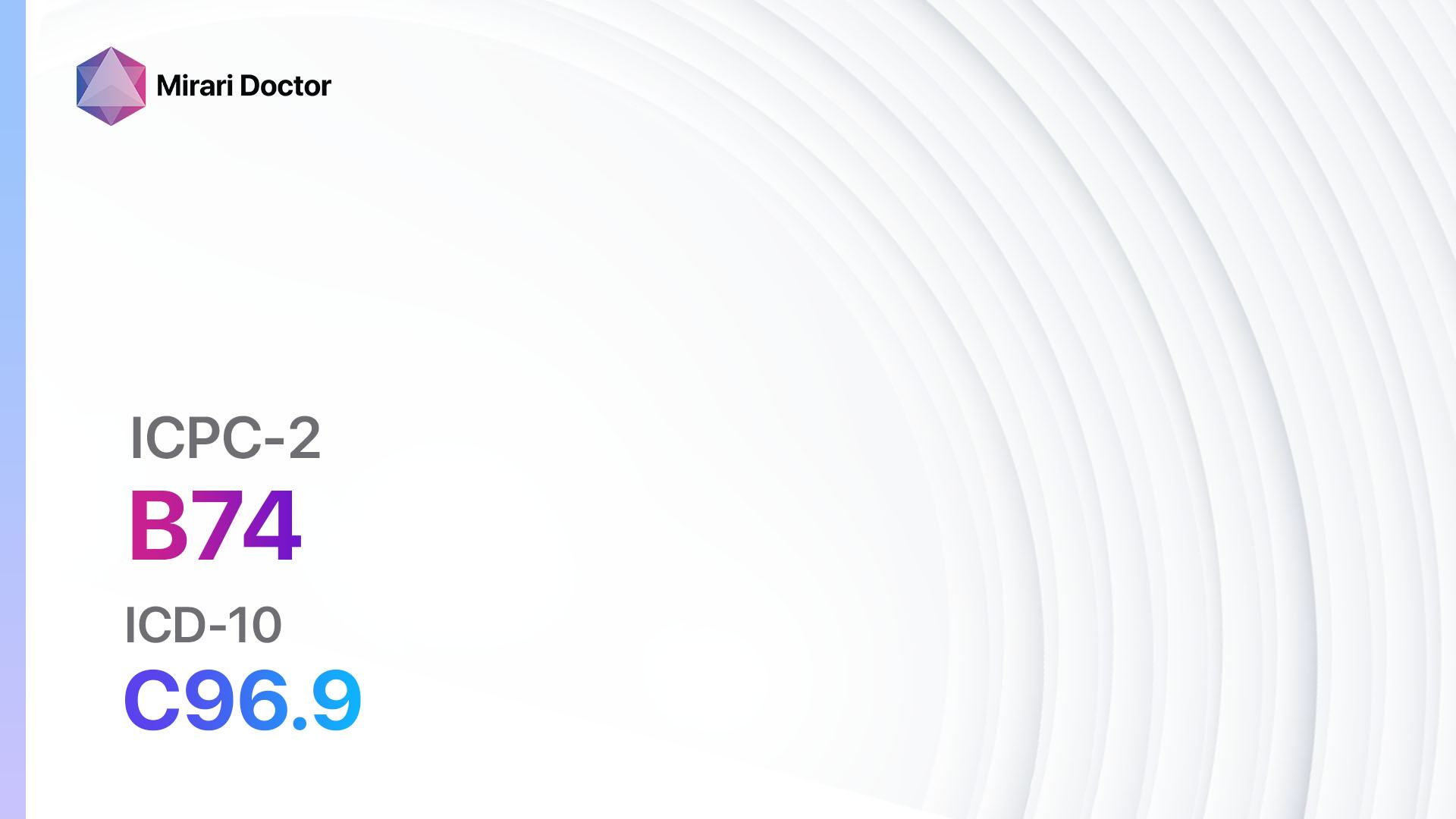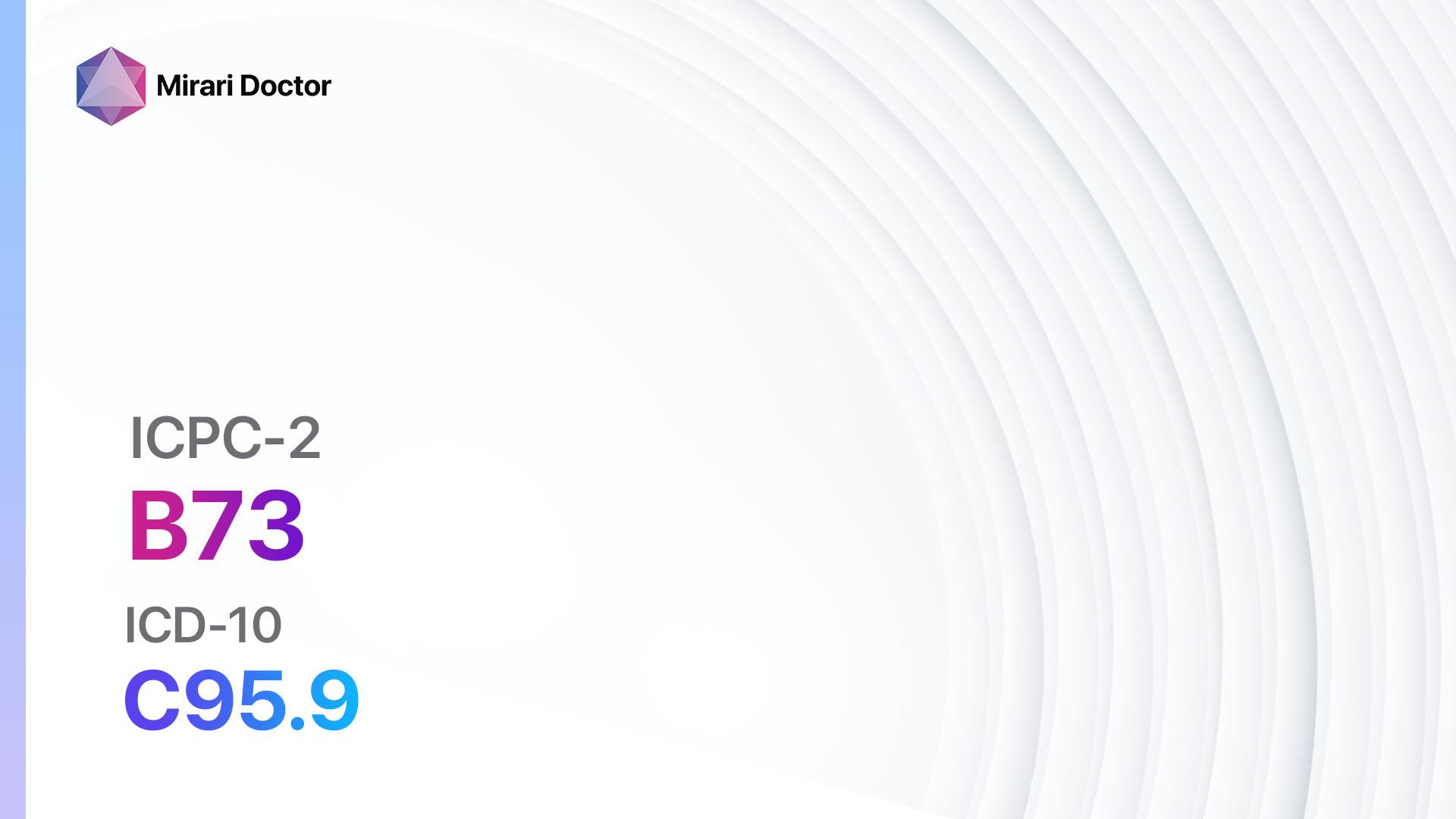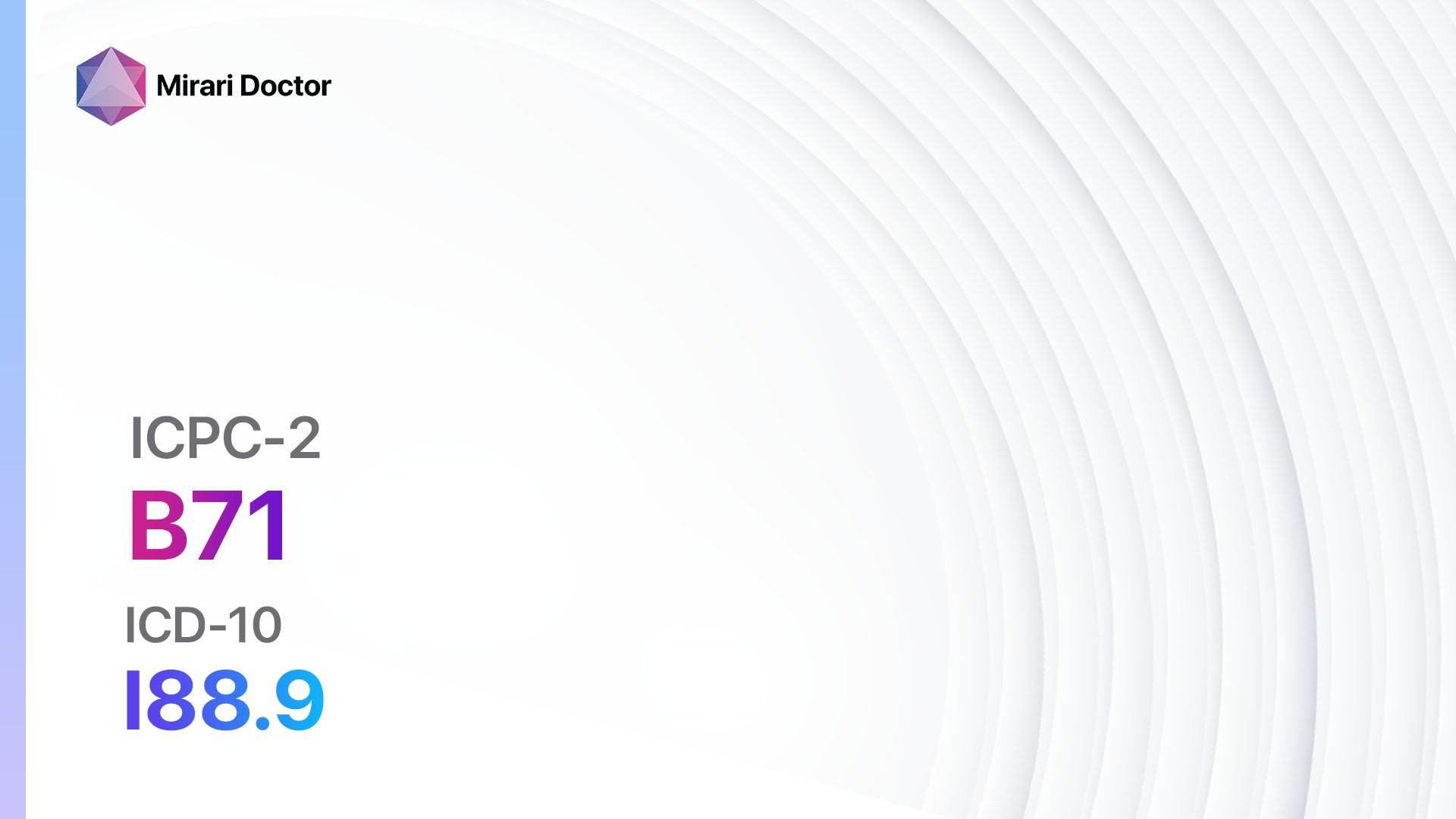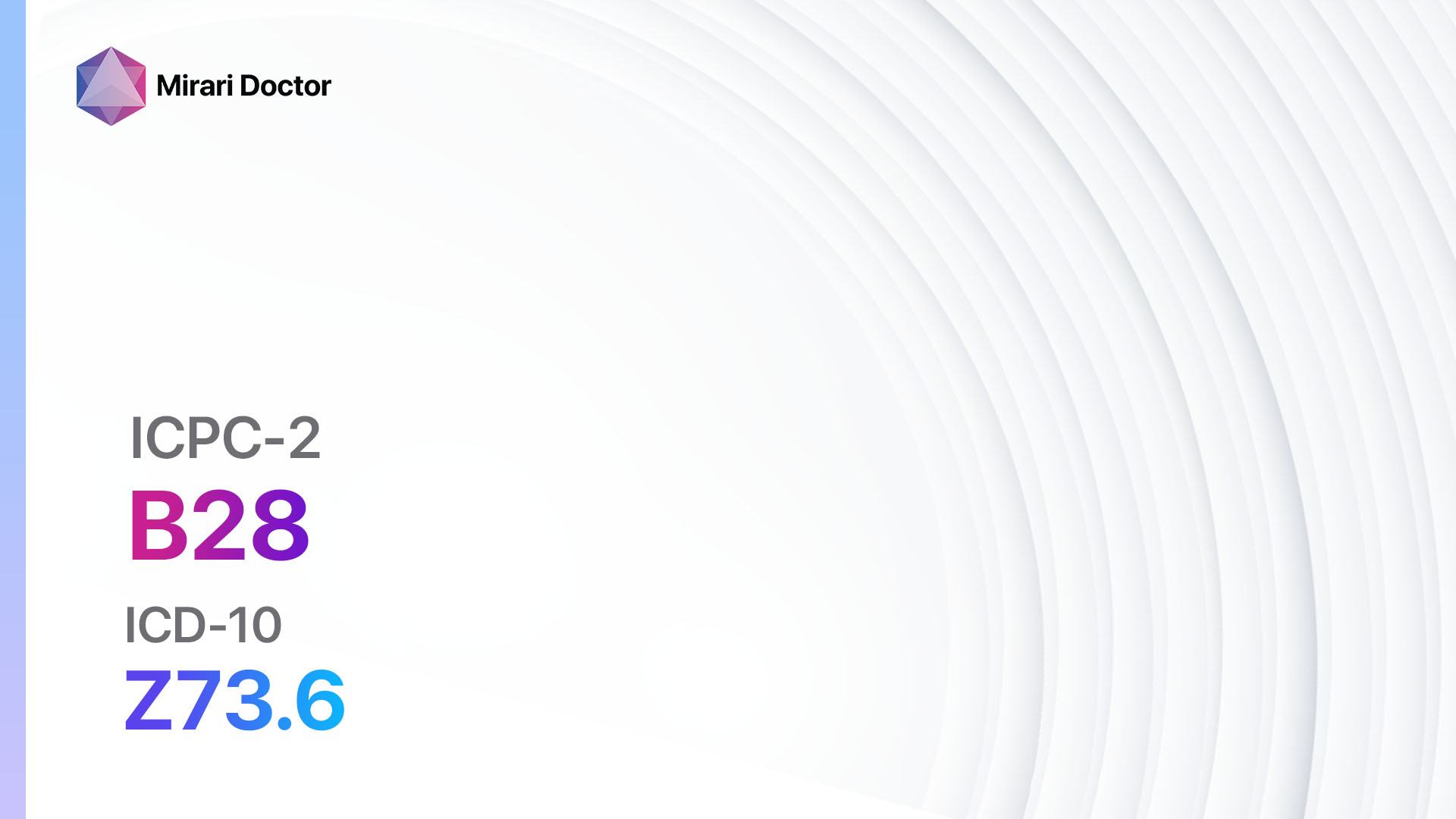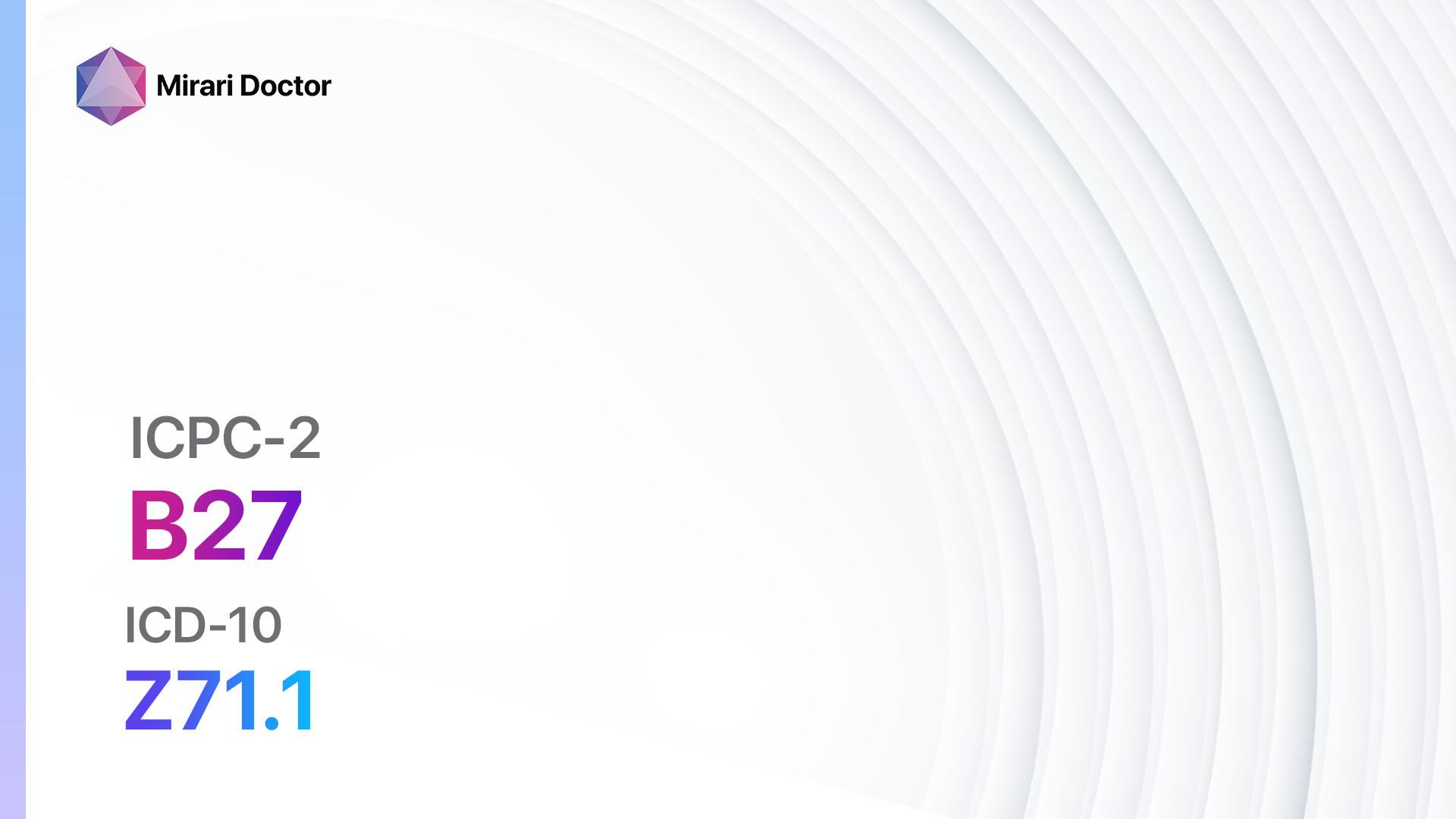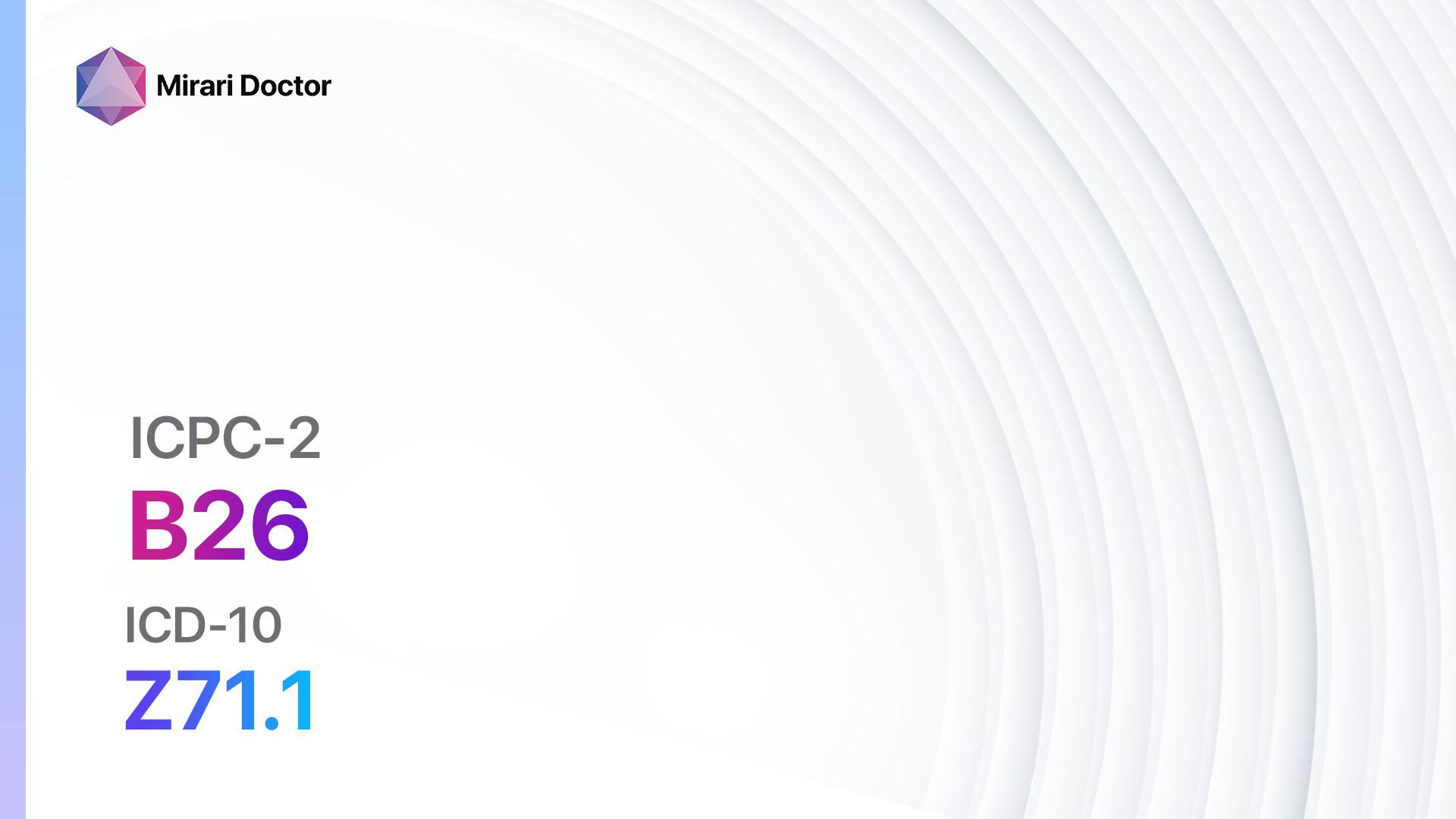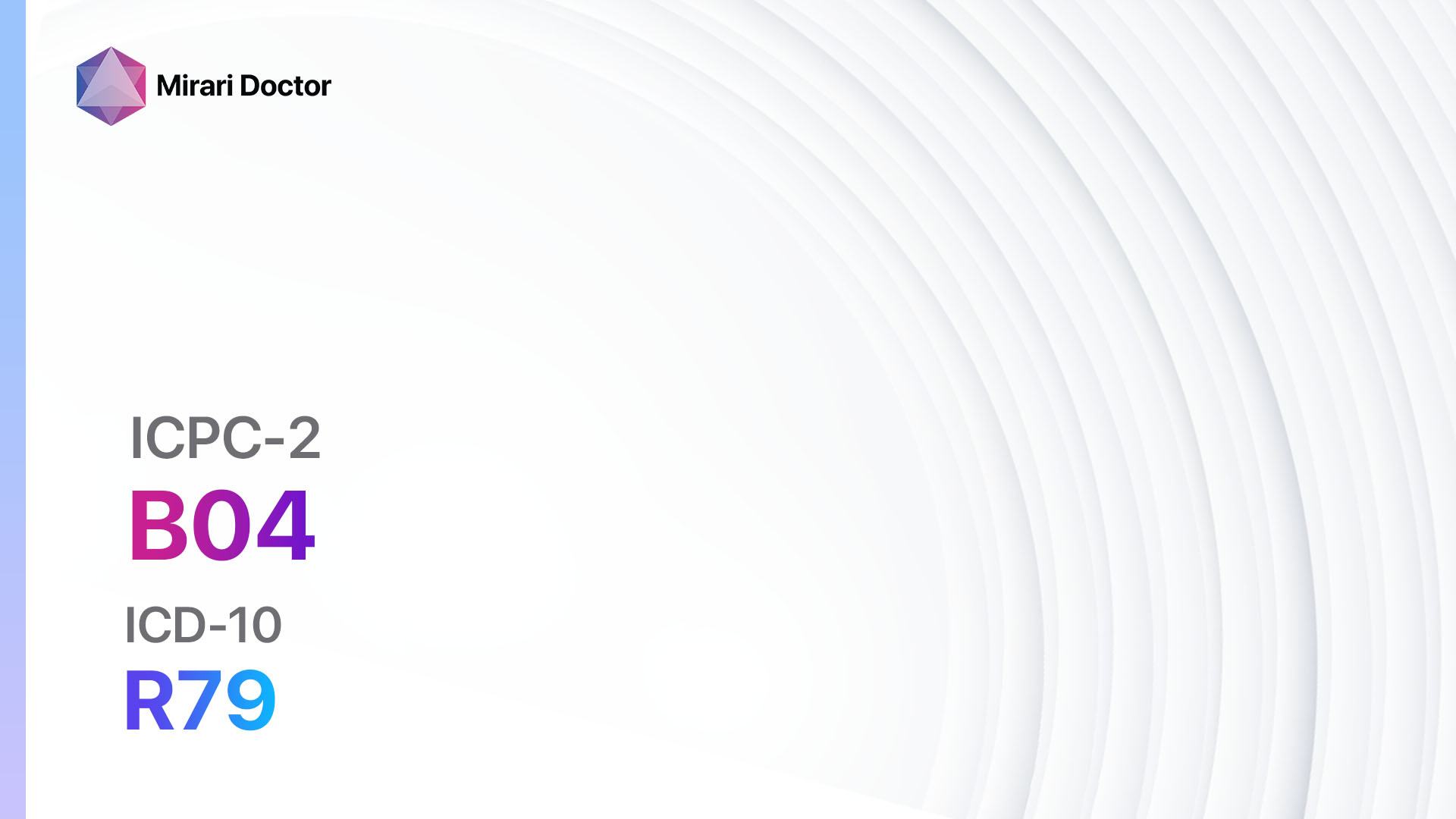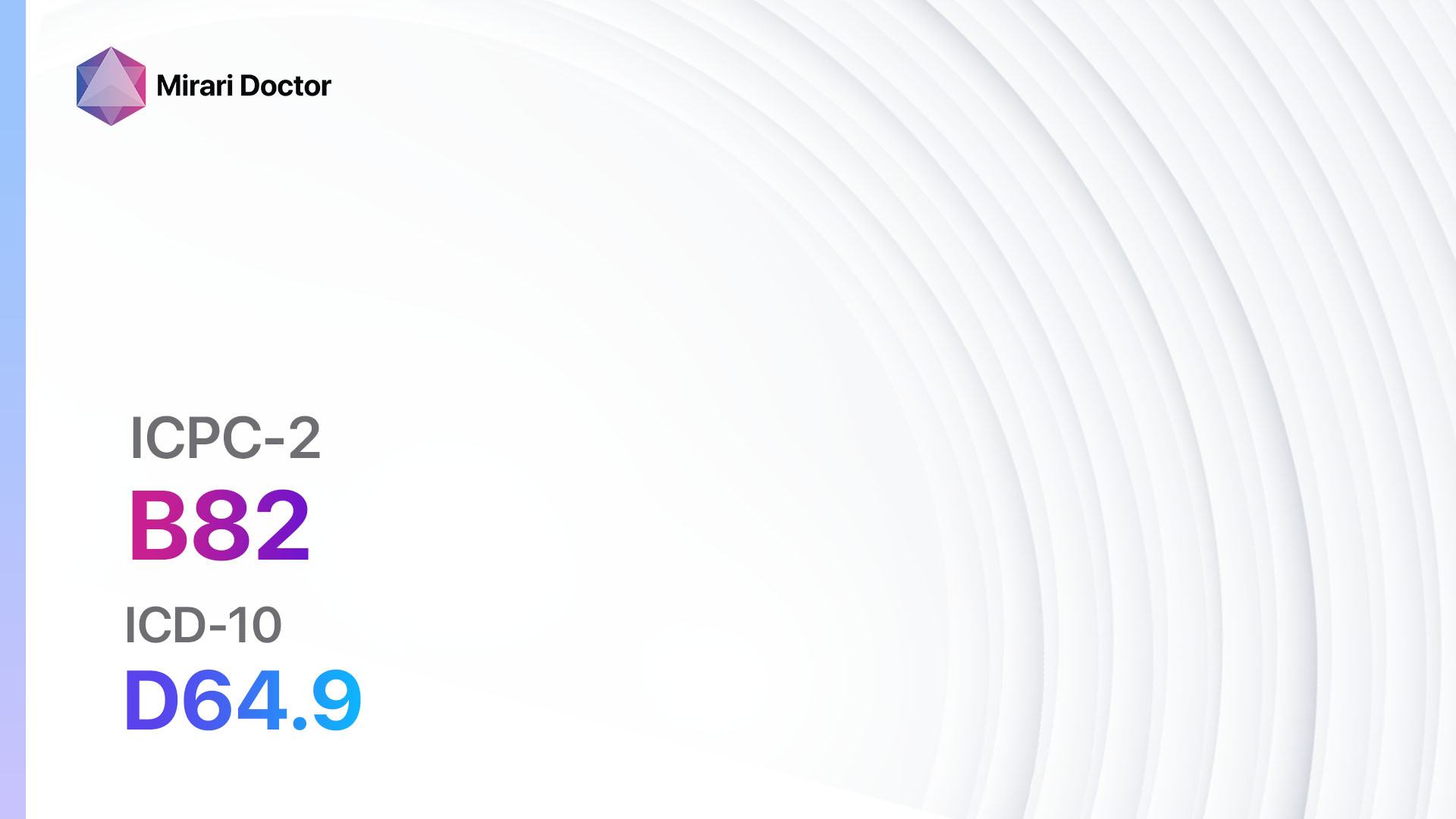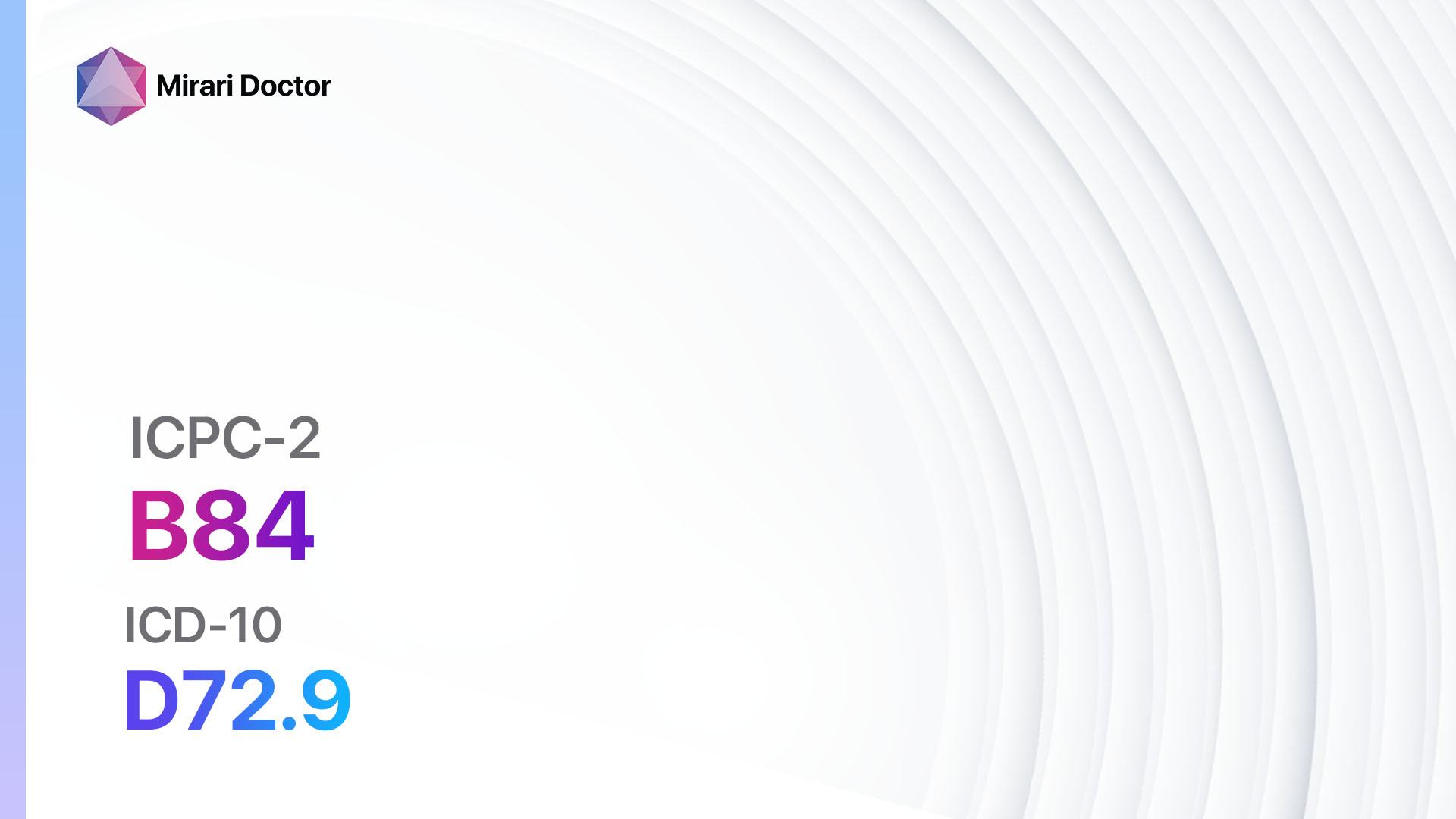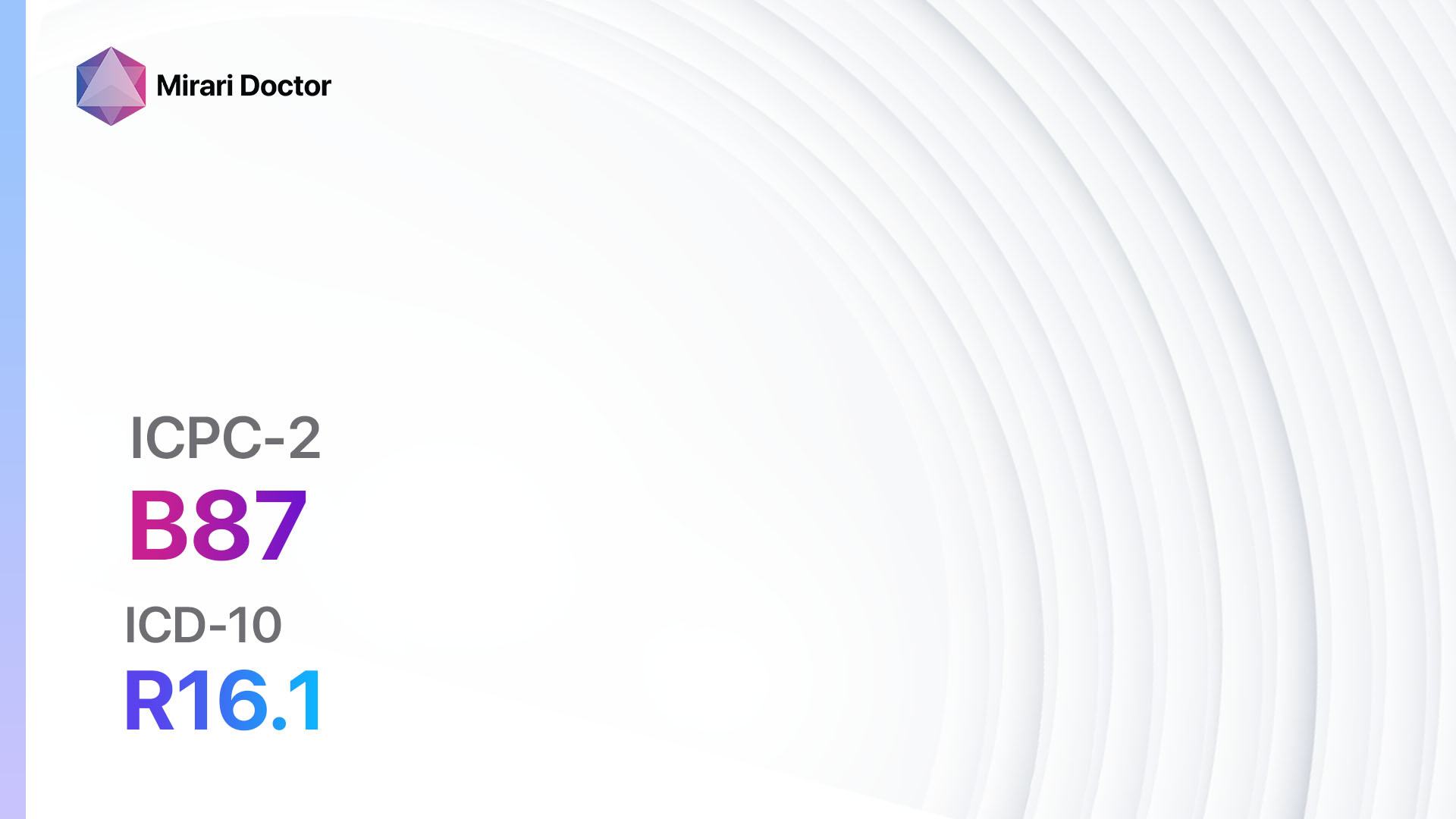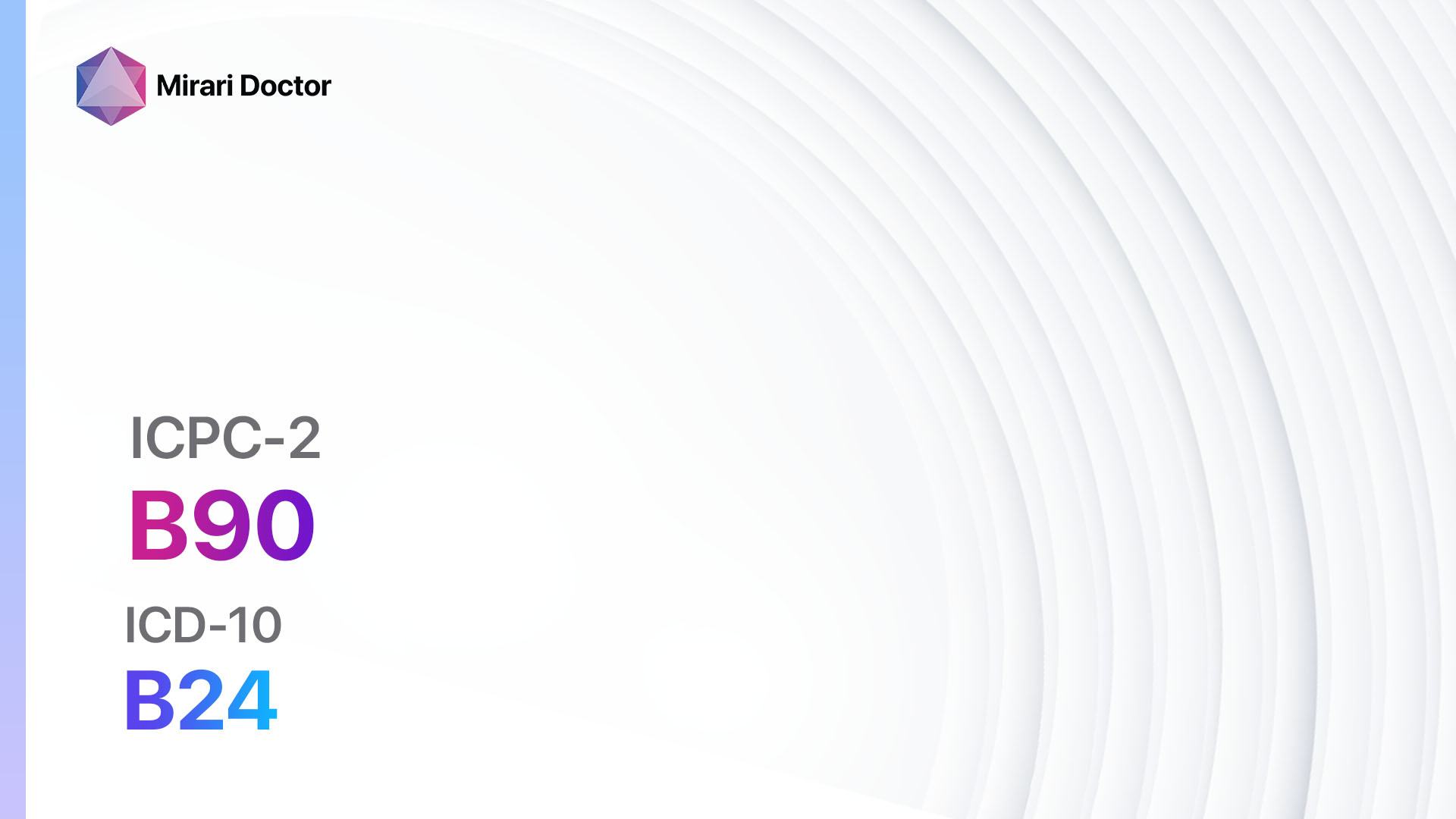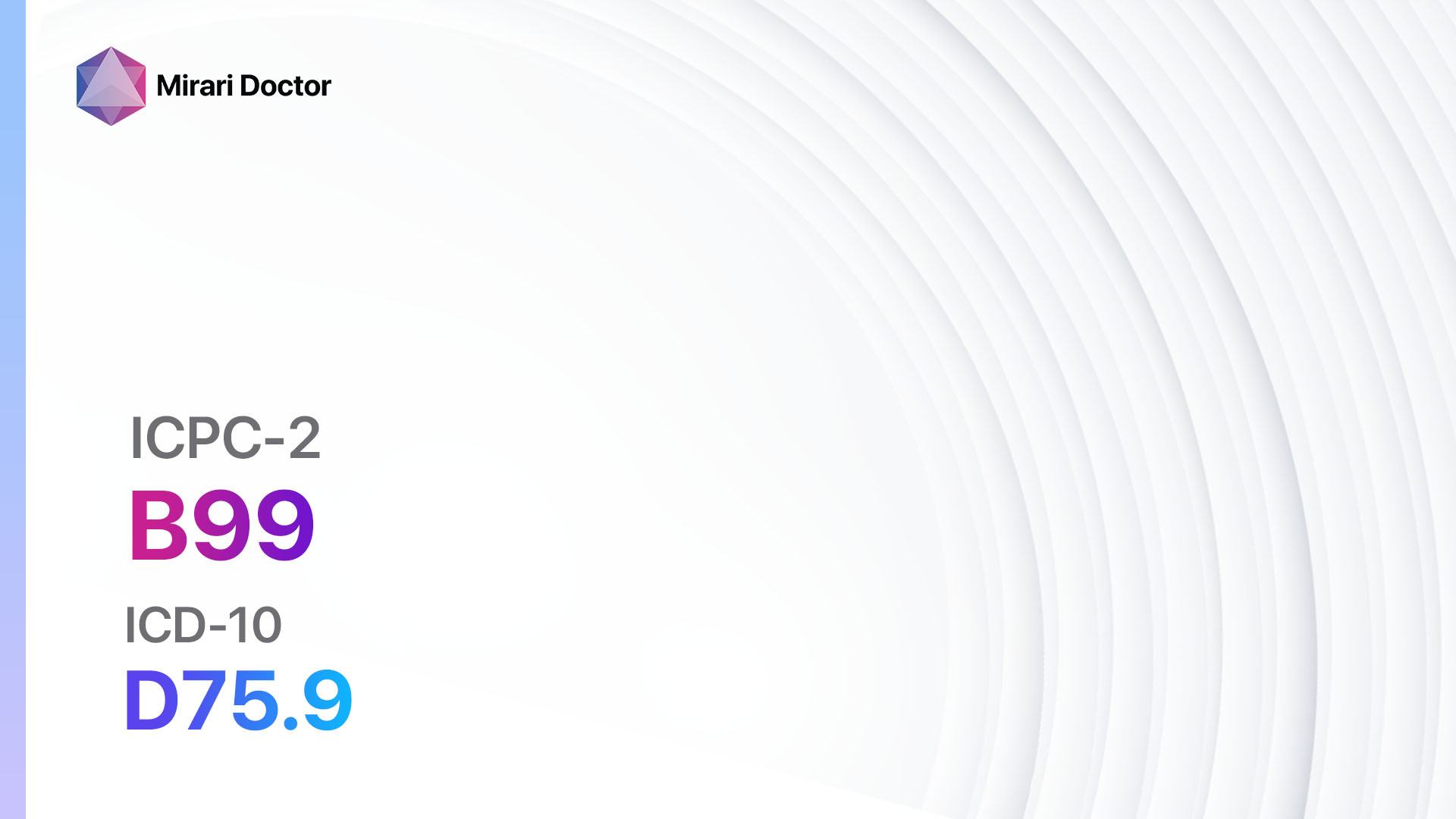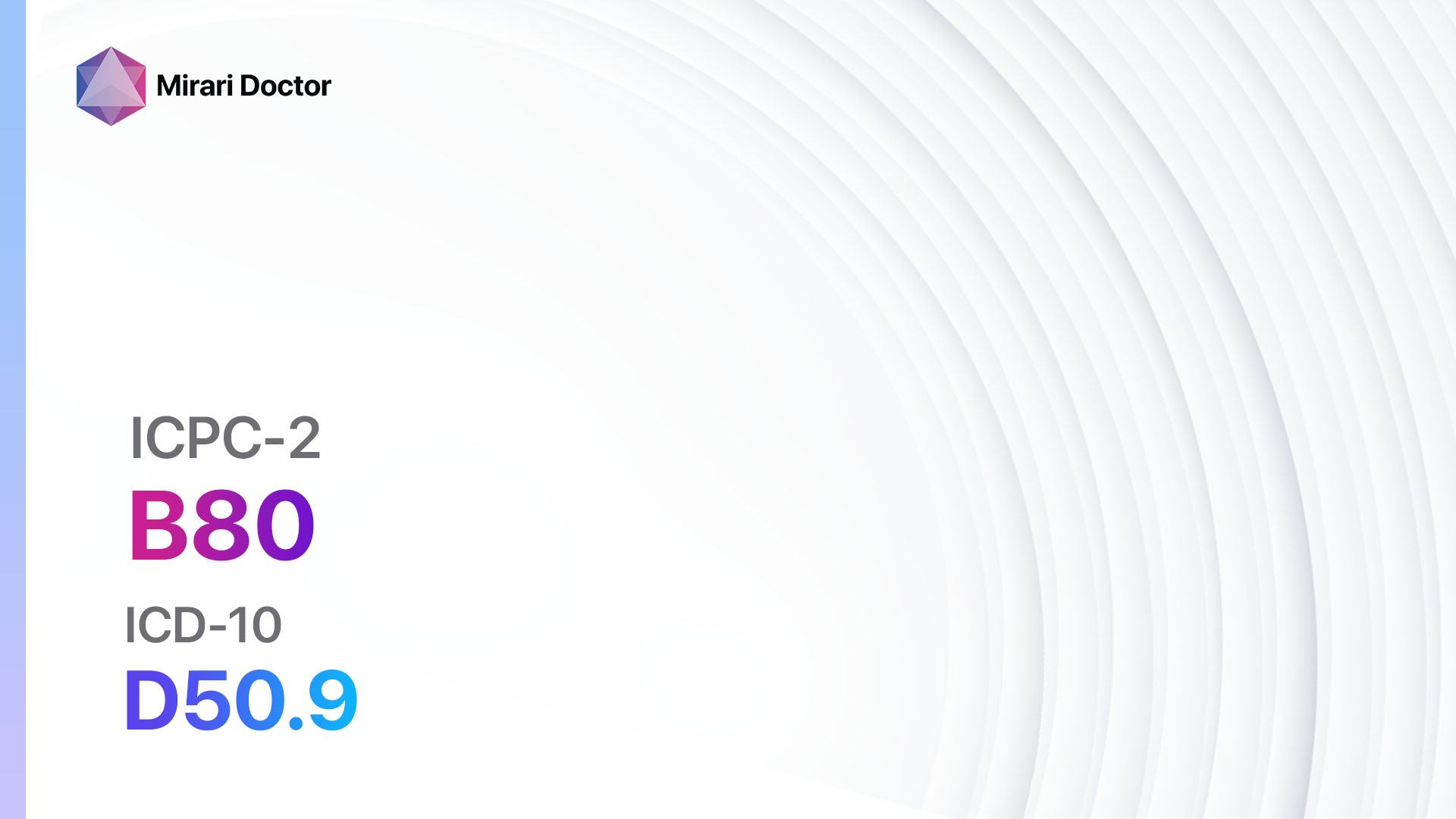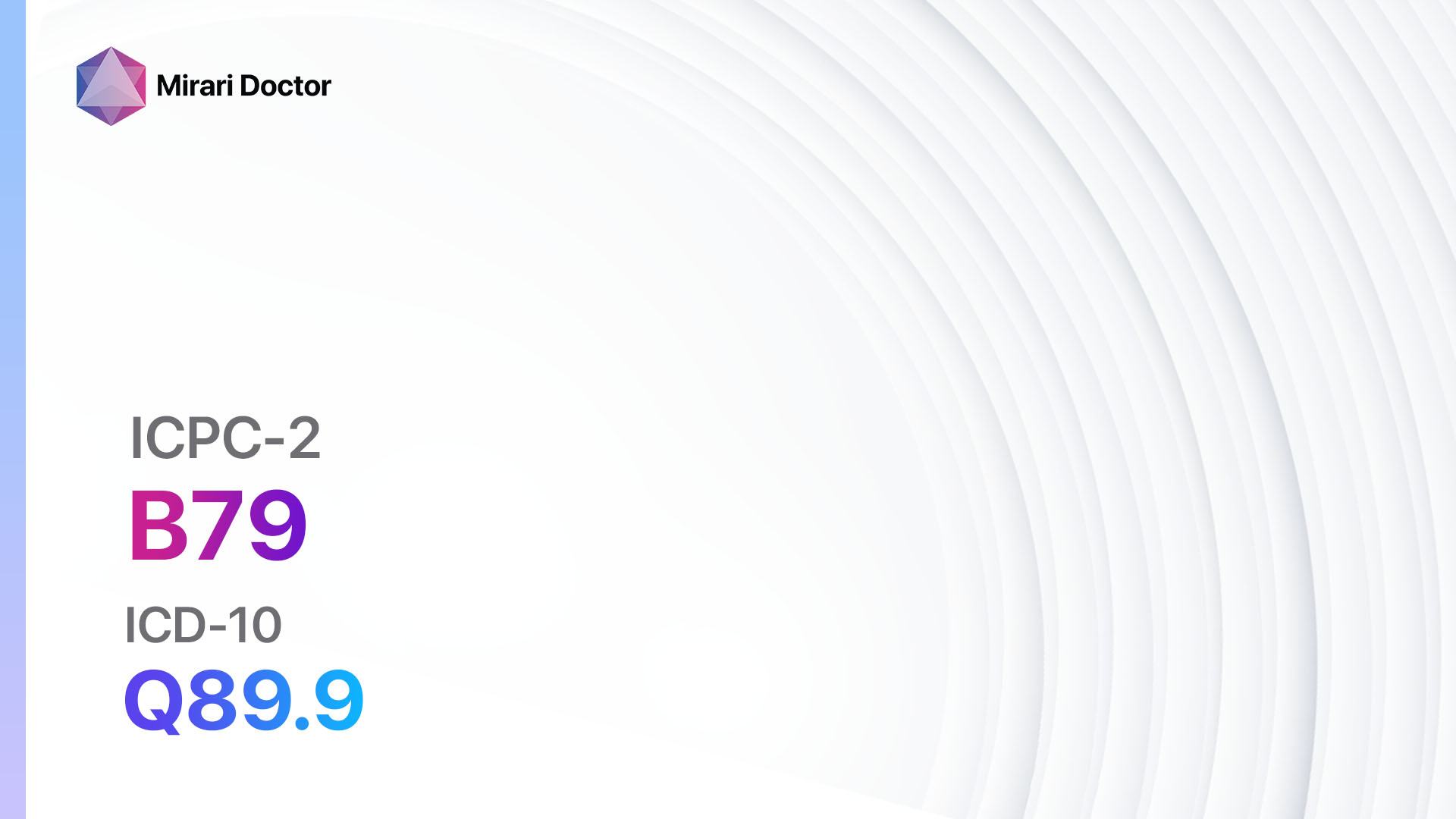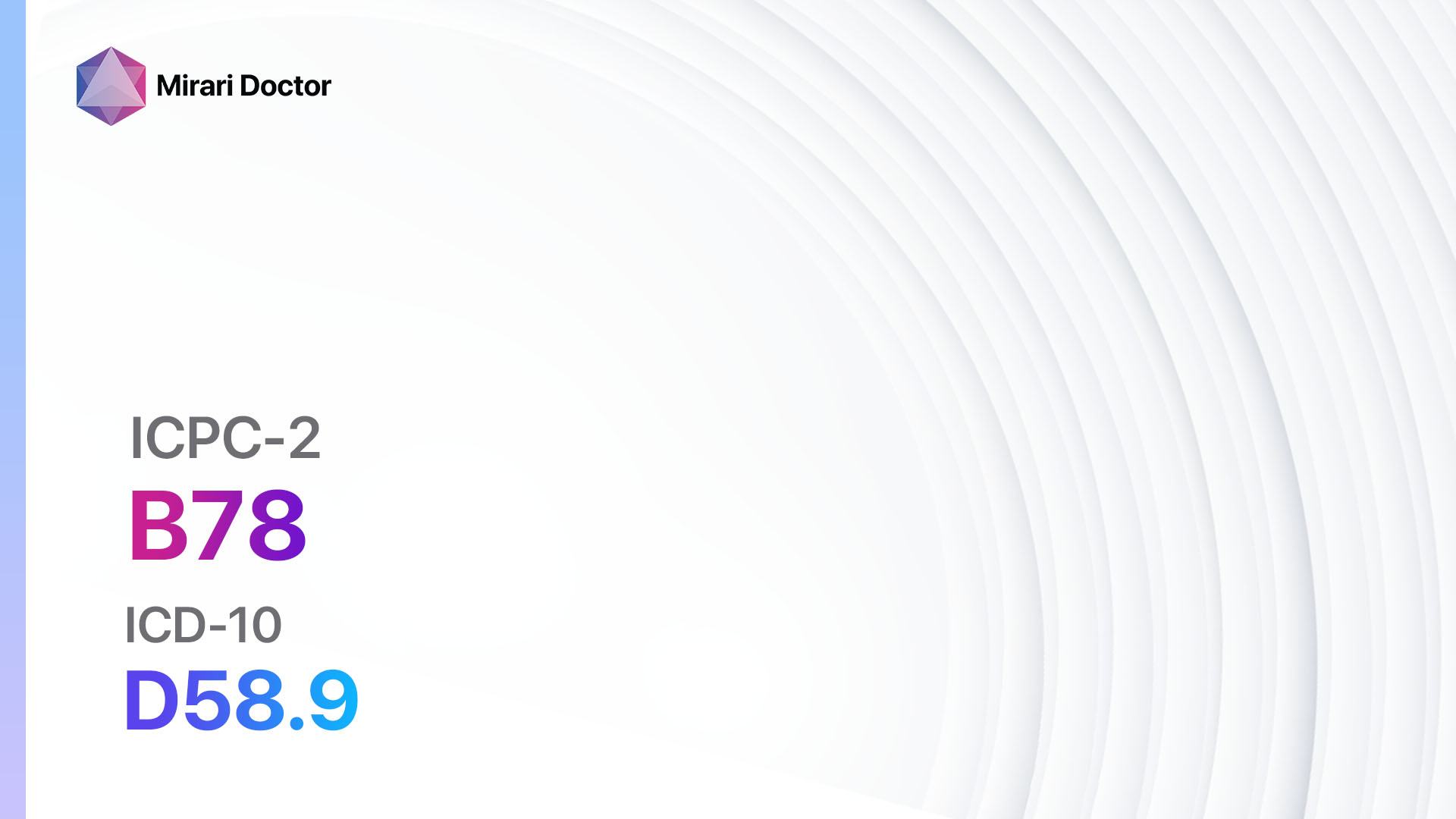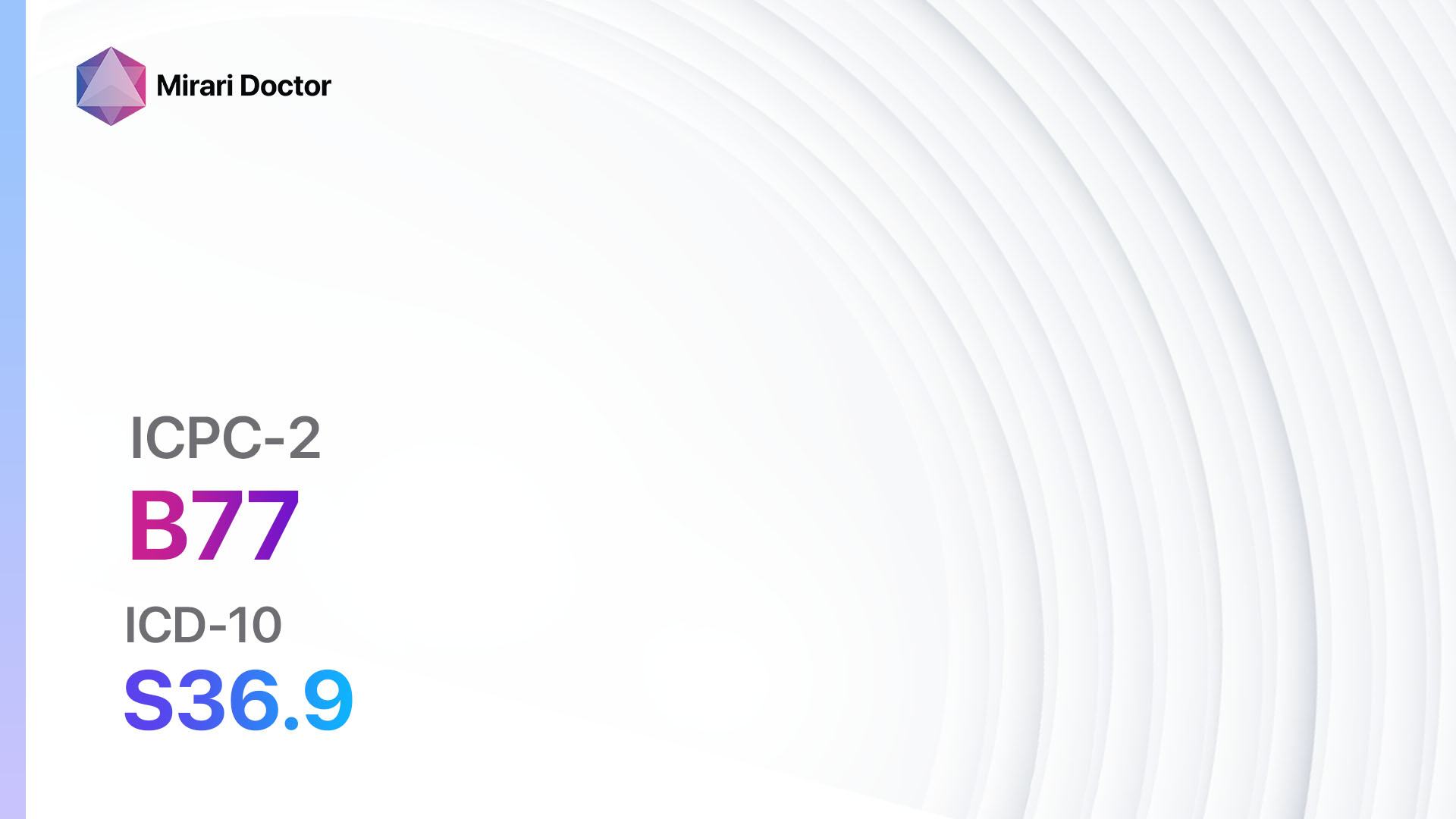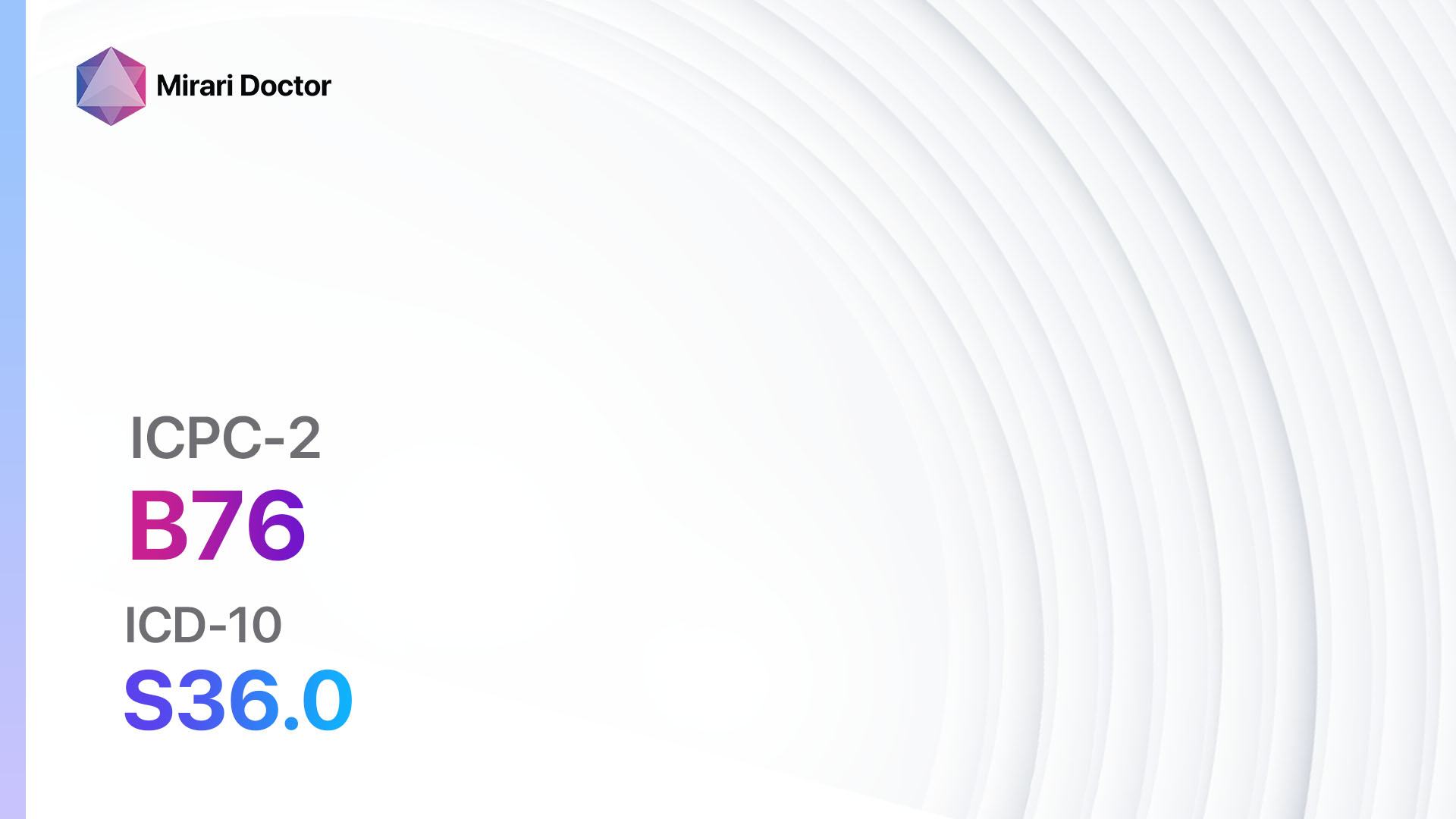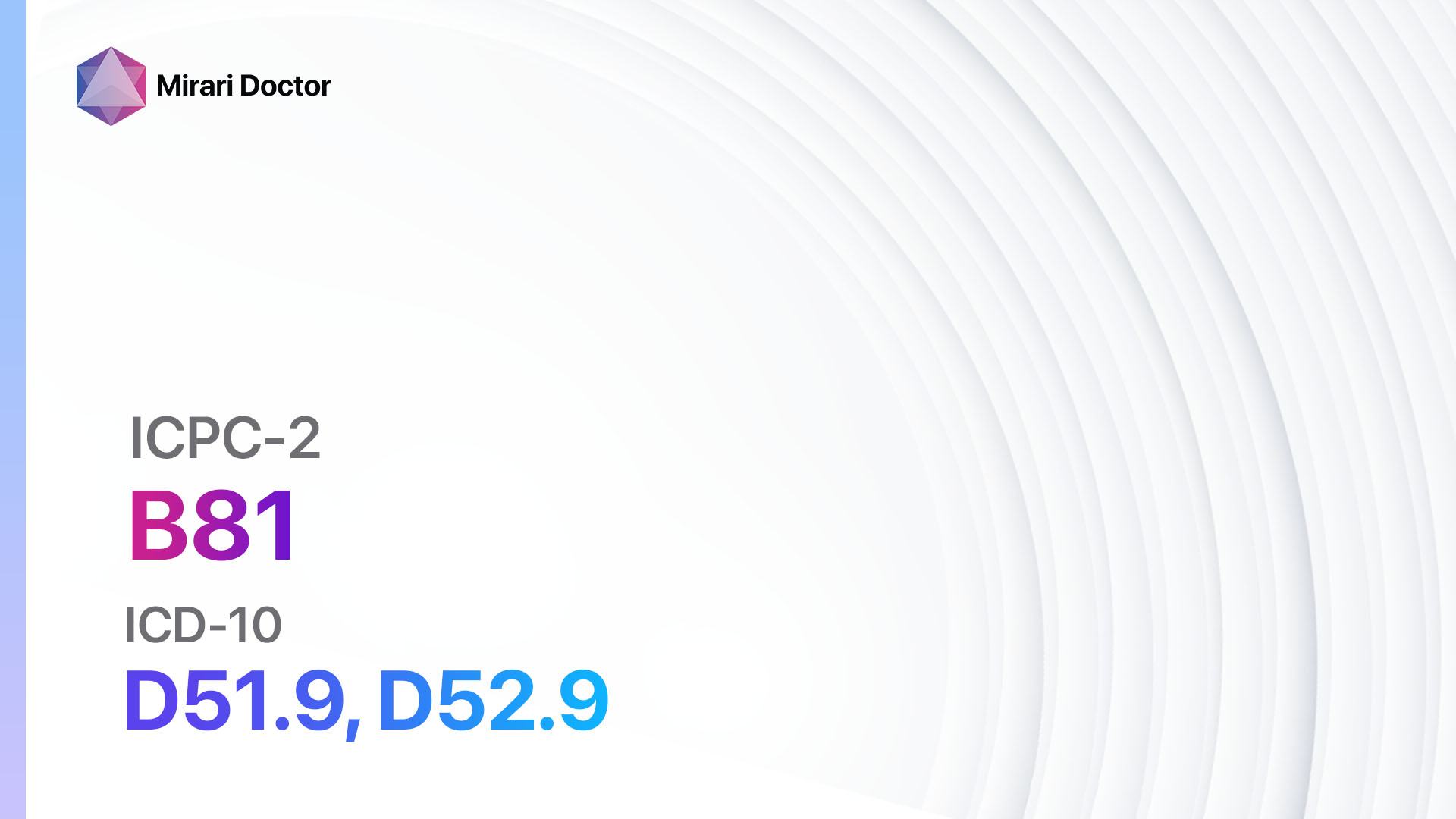
Introduction
Anemia due to vitamin B12 or folate deficiency, also known as megaloblastic anemia, is a condition characterized by the production of abnormally large, immature red blood cells that cannot function properly[1]. This occurs when the body lacks sufficient vitamin B12 (cobalamin) or folate (vitamin B9) to support normal DNA synthesis during red blood cell production[2]. Vitamin B12 and folate deficiencies are significant global health concerns, with megaloblastic anemia affecting millions worldwide, particularly older adults, vegetarians, and individuals with malabsorption disorders[3]. Early diagnosis and treatment are crucial because while many symptoms are reversible, neurological complications from vitamin B12 deficiency can become permanent if left untreated[4].
Codes
- ICPC-2 Code: B81 Anemia, Vitamin B12/folate deficiency
- ICD-10 Codes: D51.9 Vitamin B12 deficiency anemia, unspecified; D52.9 Folate deficiency anemia, unspecified[5]
Symptoms
The clinical presentation of vitamin B12 and folate deficiency encompasses both hematologic and systemic manifestations[6]:
Hematologic Symptoms
- Fatigue and weakness: Most common presenting symptoms due to reduced oxygen-carrying capacity[7]
- Pallor: Pale skin, particularly noticeable in nail beds, palms, and conjunctiva[1]
- Shortness of breath (dyspnea): Especially during physical exertion as the body compensates for decreased oxygen delivery[8]
- Rapid or irregular heartbeat (tachycardia): Compensatory mechanism to maintain tissue oxygenation[9]
Gastrointestinal Symptoms
- Glossitis: Smooth, red, sore tongue, often one of the earliest signs[10]
- Mouth ulcers: Painful oral lesions that may interfere with eating[1]
- Loss of appetite and weight loss: May result from glossitis and gastrointestinal discomfort[11]
- Diarrhea and nausea: Common gastrointestinal manifestations[12]
Neurological Symptoms (Primarily B12 Deficiency)
- Paresthesias: Numbness and tingling sensations, typically in hands and feet[13]
- Balance and gait problems: Due to peripheral neuropathy and subacute combined degeneration of the spinal cord[14]
- Cognitive impairment: Memory problems, confusion, and difficulty concentrating[15]
- Psychiatric symptoms: Depression, anxiety, irritability, and in severe cases, dementia-like symptoms[16]
- Vision problems: Optic nerve atrophy in severe cases[17]
Important Clinical Note
Severe neurological disease may occur without anemia or macrocytosis, particularly in B12 deficiency[18]. In rare cases, neurological symptoms may be the presenting feature before hematologic abnormalities develop[19].
Causes
Vitamin B12 Deficiency Causes
Decreased Intake
- Dietary deficiency: Strict vegetarian/vegan diets without B12 supplementation[20]
- Malnutrition: Inadequate overall nutritional intake[21]
Malabsorption
- Pernicious anemia: Autoimmune destruction of gastric parietal cells leading to intrinsic factor deficiency, affecting 1-2% of adults over 60[22]
- Gastrectomy: Surgical removal of stomach reduces intrinsic factor production[23]
- Ileal disease: Crohn’s disease, surgical resection, or bacterial overgrowth affecting terminal ileum absorption[24]
- Pancreatic insufficiency: Impaired release of B12 from food proteins[25]
Medication-Induced
- Metformin: Long-term use can reduce B12 absorption[26]
- Proton pump inhibitors (PPIs): Reduce gastric acid needed for B12 liberation from food[27]
- H2 receptor antagonists: Similar mechanism to PPIs[28]
Folate Deficiency Causes
Inadequate Intake
- Poor diet: Limited consumption of folate-rich foods (leafy greens, legumes, fortified grains)[29]
- Alcohol abuse: Interferes with folate absorption and increases folate requirements[30]
Increased Requirements
- Pregnancy and lactation: Folate needs increase 50-100% during pregnancy[31]
- Hemolytic anemia: Chronic blood cell destruction increases folate turnover[32]
- Malignancy: Rapidly dividing cancer cells consume large amounts of folate[33]
Malabsorption
- Celiac disease: Damages small intestine affecting folate absorption[34]
- Inflammatory bowel disease: Crohn’s disease and ulcerative colitis impair absorption[35]
- Tropical sprue: Endemic intestinal disease affecting folate absorption[36]
Drug-Induced
- Methotrexate: Folate antagonist used in chemotherapy and autoimmune diseases[37]
- Anticonvulsants: Phenytoin, carbamazepine interfere with folate metabolism[38]
- Trimethoprim-sulfamethoxazole: Inhibits folate metabolism[39]
Diagnostic Steps
Medical History
Comprehensive history should assess[40]:
- Dietary assessment: Vegetarian/vegan status, alcohol consumption, general nutrition
- Gastrointestinal symptoms: Previous surgeries, malabsorption syndromes, inflammatory bowel disease
- Medication review: PPIs, metformin, anticonvulsants, chemotherapy agents
- Family history: Pernicious anemia, autoimmune diseases, genetic disorders
- Neurological symptoms: Onset and progression of paresthesias, balance problems, cognitive changes
- Pregnancy status: Current or recent pregnancy increases folate requirements
Physical Examination
Systematic examination should include[41]:
- General appearance: Pallor, jaundice (mild), overall nutritional status
- Oral examination: Glossitis (smooth, red tongue), angular cheilitis, oral ulcers
- Cardiovascular: Tachycardia, flow murmurs, signs of heart failure in severe cases
- Neurological assessment: Vibration sense, position sense, reflexes, gait assessment, mental status examination
- Abdominal examination: Hepatosplenomegaly (mild), tenderness
- Skin examination: Hyperpigmentation, particularly over knuckles in B12 deficiency
Laboratory Tests
Initial Hematologic Studies
- Complete Blood Count (CBC): Reveals macrocytic anemia with mean corpuscular volume (MCV) typically >100 fL[42]
- Peripheral blood smear: Shows macro-ovalocytes, hypersegmented neutrophils (≥6 lobes), and potentially pancytopenia[43]
- Reticulocyte count: Usually low, reflecting impaired DNA synthesis[44]
Vitamin Level Assessment
- Serum vitamin B12: Levels <200 pg/mL (148 pmol/L) indicate deficiency; borderline levels 200-350 pg/mL require further testing[18]
- Serum folate: Levels <2 ng/mL (4.5 nmol/L) indicate deficiency; borderline 2-4 ng/mL[45]
- Red blood cell folate: Better reflects long-term folate status than serum folate[46]
Metabolic Markers
- Methylmalonic acid (MMA): Elevated levels (>0.4 μmol/L) are highly sensitive for B12 deficiency, including early stages[47]
- Homocysteine: Elevated in both B12 and folate deficiency (normal <15 μmol/L)[48]
- Holotranscobalamin (active B12): When <40 pg/mL, indicates B12 deficiency with high specificity[49]
Autoimmune Studies (for Pernicious Anemia)
- Intrinsic factor antibodies: Present in 50-70% of pernicious anemia patients; highly specific when positive[50]
- Parietal cell antibodies: Present in 90% of pernicious anemia patients but less specific[51]
- Gastrin levels: Often elevated due to achlorhydria in pernicious anemia[52]
Specialized Testing
Schilling Test (Historical)
- Purpose: Previously used to assess vitamin B12 absorption and identify pernicious anemia[53]
- Current status: Largely obsolete due to difficulty in performance, interpretation, and availability of better tests[54]
- Replacement: Metabolic markers (MMA, homocysteine) and antibody testing provide similar information
Additional Studies When Indicated
- Upper endoscopy: To evaluate for atrophic gastritis in suspected pernicious anemia[55]
- Bone marrow examination: Rarely needed; shows megaloblastic changes when performed[56]
- Genetic testing: For rare hereditary causes (transcobalamin II deficiency, hereditary folate malabsorption)[57]
Possible Interventions
Traditional Medical Interventions
Vitamin B12 Replacement Therapy
Injectable B12 (Hydroxocobalamin/Cyanocobalamin)
- Initial treatment: 1000 μg intramuscularly daily for 7 days, then weekly for 4 weeks, then monthly for life[58]
- Hydroxocobalamin: Preferred in many countries; longer half-life, better tissue retention[59]
- Cyanocobalamin: Most widely available form; requires conversion to active coenzymes[60]
- Cost: $10-100 per injection depending on formulation and location[61]
- Monitoring: B12 levels, MMA, homocysteine at 3 months; reticulocyte response within 7-10 days
Oral B12 Therapy
- High-dose oral B12: 1000-2000 μg daily, effective even in pernicious anemia due to passive absorption[62]
- Mechanism: 1-2% passive absorption independent of intrinsic factor when given in high doses[63]
- Efficacy: Studies show oral B12 as effective as intramuscular for most patients[64]
- Cost: $5-20 per month for generic formulations[65]
- Patient preference: Often preferred due to convenience and reduced healthcare visits
Sublingual and Nasal Preparations
- Sublingual B12: Methylcobalamin or cyanocobalamin absorbed through oral mucosa[66]
- Nasal spray: Cyanocobalamin 500 μg weekly after initial correction[67]
- Evidence: Limited studies show efficacy comparable to intramuscular route[68]
Folate Replacement Therapy
- Folic acid: Standard treatment, 1-5 mg daily for 4 months minimum[69]
- Pregnancy dosing: 4-5 mg daily for women at high risk; 400-800 μg daily for prevention[70]
- Cost: $3-10 per month for generic formulations[71]
- Critical precaution: Must exclude B12 deficiency before starting folate to prevent neurological progression[72]
- Response: Reticulocytosis occurs by days 3-4; anemia improves within 1-2 weeks; normalizes within 4-8 weeks[45]
Combined Therapy Considerations
- Concurrent deficiencies: Common in malabsorption syndromes, alcoholism, malnutrition[73]
- Treatment approach: Address both deficiencies simultaneously when present
- Monitoring: Follow both B12 and folate levels, plus metabolic markers
Specialized Therapies
For Methotrexate Toxicity
- Folinic acid (leucovorin): Bypasses methotrexate inhibition; 15 mg daily or as prescribed[74]
- Timing: Given 24 hours after methotrexate to allow drug effect while preventing toxicity
For Malabsorption Syndromes
- Higher doses: May require increased dosing for inflammatory bowel disease or pancreatic insufficiency
- Parenteral route: Consider for severe malabsorption or treatment-resistant cases
- Underlying condition treatment: Address celiac disease, inflammatory bowel disease, bacterial overgrowth
Emergency Management
- Severe anemia: Blood transfusion if hemoglobin <7 g/dL or symptomatic heart failure[75]
- Neurological symptoms: Urgent B12 replacement to prevent irreversible damage
- Pancytopenia: Monitor for bleeding, infection; hospitalization may be required
Alternative and Supportive Interventions
Dietary Modifications
B12-Rich Foods
- Animal products: Meat, fish, poultry, eggs, dairy products[76]
- Fortified foods: Nutritional yeast, fortified cereals, plant milks for vegetarians[77]
- Special considerations: Vegetarians and vegans require supplementation as plant foods contain minimal B12[78]
Folate-Rich Foods
- Dark leafy greens: Spinach, kale, romaine lettuce[79]
- Legumes: Lentils, chickpeas, black beans[80]
- Fortified grains: Many countries mandate folate fortification of wheat flour[81]
- Other sources: Asparagus, avocado, citrus fruits, liver[82]
Lifestyle Modifications
- Alcohol reduction: Essential for folate absorption and metabolism[83]
- Smoking cessation: Improves overall nutrient absorption and cardiovascular health[84]
- Medication review: Work with healthcare providers to minimize interference from drugs like PPIs when possible[85]
Complementary Approaches
Limited Evidence Interventions
- Probiotics: May improve gut health and nutrient absorption in malabsorption syndromes[86]
- Digestive enzymes: Theoretical benefit for B12 liberation from food proteins[87]
- Stress management: Meditation, yoga may support overall health during treatment[88]
- Costs: $10-60 per month depending on specific interventions
Important Cautions
- Herbal supplements: Limited evidence for treating vitamin deficiencies; may interfere with medications[89]
- Unproven treatments: Avoid expensive therapies without scientific evidence
- Medical supervision: All complementary approaches should complement, not replace, standard treatment
Follow-up and Patient Education
Monitoring Schedule
- Initial response: Blood count and reticulocyte count at 7-10 days to confirm treatment response[90]
- Early follow-up: Complete blood count at 8 weeks to assess hematologic recovery[91]
- Long-term monitoring: Annual B12 and folate levels for patients on maintenance therapy[92]
- Neurological assessment: Regular evaluation of neurological symptoms, which may take months to improve[93]
Treatment Response Indicators
- Reticulocytosis: Increase in young red blood cells within 3-7 days indicates effective treatment[94]
- Hematologic improvement: Hemoglobin should increase by 1-2 g/dL per month[95]
- Symptom resolution: Fatigue and weakness typically improve within weeks; neurological symptoms may take months[96]
Patient Education Priorities
Understanding the Condition
- Chronic nature: Most patients with pernicious anemia or malabsorption require lifelong treatment[97]
- Irreversible damage: Emphasize importance of early treatment to prevent permanent neurological complications[98]
- Different vitamins: Explain distinct roles of B12 and folate, why both may be needed[99]
Treatment Compliance
- Medication adherence: Critical importance of consistent supplementation[100]
- Route options: Discuss preferences between injection, oral, sublingual, or nasal preparations
- Monitoring needs: Regular blood tests to ensure adequate treatment response
Dietary Guidance
- Balanced nutrition: Importance of varied diet including fortified foods[101]
- Special populations: Vegetarians need reliable B12 sources; pregnant women need adequate folate[102]
- Food interactions: Alcohol interferes with folate; certain medications affect absorption
When to Seek Medical Attention
- Worsening symptoms: Progressive weakness, neurological symptoms, signs of heart failure
- Treatment side effects: Allergic reactions, injection site problems
- Associated conditions: Symptoms of autoimmune diseases often associated with pernicious anemia
Long-term Management Considerations
- Associated autoimmune diseases: Screen for thyroid disease, diabetes, other autoimmune conditions in pernicious anemia[103]
- Gastric cancer screening: Some guidelines recommend periodic screening for gastric neoplasia in pernicious anemia[104]
- Family counseling: Genetic counseling for rare hereditary forms; family screening for pernicious anemia[105]
Mirari Cold Plasma Alternative Intervention
Understanding Mirari Cold Plasma
- Safe and Non-Invasive Treatment: Mirari Cold Plasma is a safe and non-invasive treatment option for various skin conditions. It does not require incisions, minimizing the risk of scarring, bleeding, or tissue damage.
- Efficient Extraction of Foreign Bodies: Mirari Cold Plasma facilitates the removal of foreign bodies from the skin by degrading and dissociating organic matter, allowing easier access and extraction.
- Pain Reduction and Comfort: Mirari Cold Plasma has a local analgesic effect, providing pain relief during the treatment, making it more comfortable for the patient.
- Reduced Risk of Infection: Mirari Cold Plasma has antimicrobial properties, effectively killing bacteria and reducing the risk of infection.
- Accelerated Healing and Minimal Scarring: Mirari Cold Plasma stimulates wound healing and tissue regeneration, reducing healing time and minimizing the formation of scars.
Mirari Cold Plasma Prescription
Video instructions for using Mirari Cold Plasma Device – B81 Anemia, Vitamin B12/folate def. (ICD-10:D51.9, D52.9)
| Mild | Moderate | Severe |
| Mode setting: 7 (Immunotherapy) Location: 1 (Sacrum) Morning: 15 minutes, Evening: 15 minutes |
Mode setting: 7 (Immunotherapy) Location: 1 (Sacrum) Morning: 30 minutes, Lunch: 30 minutes, Evening: 30 minutes |
Mode setting: 7 (Immunotherapy) Location: 1 (Sacrum) Morning: 30 minutes, Lunch: 30 minutes, Evening: 30 minutes |
| Mode setting: 7 (Immunotherapy) Location: 4 (Heart, Bile & Pancreas) Morning: 15 minutes, Evening: 15 minutes |
Mode setting: 7 (Immunotherapy) Location: 4 (Heart, Bile & Pancreas) Morning: 30 minutes, Lunch: 30 minutes, Evening: 30 minutes |
Mode setting: 7 (Immunotherapy) Location: 4 (Heart, Bile & Pancreas) Morning: 30 minutes, Lunch: 30 minutes, Evening: 30 minutes |
| Mode setting: 7 (Immunotherapy) Location: 7 (Neuro system & ENT) Morning: 15 minutes, Evening: 15 minutes |
Mode setting: 7 (Immunotherapy) Location: 7 (Neuro system & ENT) Morning: 30 minutes, Lunch: 30 minutes, Evening: 30 minutes |
Mode setting: 7 (Immunotherapy) Location: 7 (Neuro system & ENT) Morning: 30 minutes, Lunch: 30 minutes, Evening: 30 minutes |
| Total Morning: 45 minutes approx. $7.50 USD, Evening: 45 minutes approx. $7.50 USD |
Total Morning: 90 minutes approx. $15 USD, Lunch: 90 minutes approx. $15 USD, Evening: 90 minutes approx. $15 USD |
Total Morning: 90 minutes approx. $15 USD, Lunch: 90 minutes approx. $15 USD, Evening: 90 minutes approx. $15 USD |
| Usual treatment for 7-60 days approx. $105 USD – $900 USD | Usual treatment for 6-8 weeks approx. $1,890 USD – $2,520 USD |
Usual treatment for 3-6 months approx. $4,050 USD – $8,100 USD
|
 |
|
Use the Mirari Cold Plasma device to treat Anemia, Vitamin B12/folate def. effectively.
WARNING: MIRARI COLD PLASMA IS DESIGNED FOR THE HUMAN BODY WITHOUT ANY ARTIFICIAL OR THIRD PARTY PRODUCTS. USE OF OTHER PRODUCTS IN COMBINATION WITH MIRARI COLD PLASMA MAY CAUSE UNPREDICTABLE EFFECTS, HARM OR INJURY. PLEASE CONSULT A MEDICAL PROFESSIONAL BEFORE COMBINING ANY OTHER PRODUCTS WITH USE OF MIRARI.
Step 1: Cleanse the Skin
- Start by cleaning the affected area of the skin with a gentle cleanser or mild soap and water. Gently pat the area dry with a clean towel.
Step 2: Prepare the Mirari Cold Plasma device
- Ensure that the Mirari Cold Plasma device is fully charged or has fresh batteries as per the manufacturer’s instructions. Make sure the device is clean and in good working condition.
- Switch on the Mirari device using the power button or by following the specific instructions provided with the device.
- Some Mirari devices may have adjustable settings for intensity or treatment duration. Follow the manufacturer’s instructions to select the appropriate settings based on your needs and the recommended guidelines.
Step 3: Apply the Device
- Place the Mirari device in direct contact with the affected area of the skin. Gently glide or hold the device over the skin surface, ensuring even coverage of the area experiencing.
- Slowly move the Mirari device in a circular motion or follow a specific pattern as indicated in the user manual. This helps ensure thorough treatment coverage.
Step 4: Monitor and Assess:
- Keep track of your progress and evaluate the effectiveness of the Mirari device in managing your Anemia, Vitamin B12/folate def.. If you have any concerns or notice any adverse reactions, consult with your health care professional.
Note
This guide is for informational purposes only and should not replace the advice of a medical professional. Always consult with your healthcare provider or a qualified medical professional for personal advice, diagnosis, or treatment. Do not solely rely on the information presented here for decisions about your health. Use of this information is at your own risk. The authors of this guide, nor any associated entities or platforms, are not responsible for any potential adverse effects or outcomes based on the content.
Mirari Cold Plasma System Disclaimer
- Purpose: The Mirari Cold Plasma System is a Class 2 medical device designed for use by trained healthcare professionals. It has received clearance from the U.S. FDA and is registered for use in Thailand and Vietnam. It is not intended for use outside of these locations.
- Informational Use: The content and information provided with the device are for educational and informational purposes only. They are not a substitute for professional medical advice or care.
- Variable Outcomes: While the device is approved for specific uses, individual outcomes can differ. We do not assert or guarantee specific medical outcomes.
- Consultation: Prior to utilizing the device or making decisions based on its content, it is essential to consult with a Certified Mirari Tele-Therapist and your medical healthcare provider regarding specific protocols.
- Liability: By using this device, users are acknowledging and accepting all potential risks. Neither the manufacturer nor the distributor will be held accountable for any adverse reactions, injuries, or damages stemming from its use.
- Geographical Availability: This device has received approval for designated purposes by the Thai and Vietnam FDA. As of now, outside of Thailand and Vietnam, the Mirari Cold Plasma System is not available for purchase or use.
References
- NHS. Vitamin B12 or folate deficiency anaemia. 2024. Available from: https://www.nhs.uk/conditions/vitamin-b12-or-folate-deficiency-anaemia/
- HSE Ireland. Vitamin B12 or folate deficiency anaemia. 2024. Available from: https://www2.hse.ie/conditions/vitamin-b12-or-folate-deficiency-anaemia/
- Mayo Clinic. Vitamin deficiency anemia – Symptoms & causes. 2024. Available from: https://www.mayoclinic.org/diseases-conditions/vitamin-deficiency-anemia/symptoms-causes/syc-20355025
- NHS. Vitamin B12 or folate deficiency anaemia – Causes. 2025. Available from: https://www.nhs.uk/conditions/vitamin-b12-or-folate-deficiency-anaemia/causes/
- World Health Organization. International Classification of Diseases, 10th Revision (ICD-10). Geneva: WHO Press; 2019.
- NHS 111 Wales. Anaemia, vitamin B12 and folate deficiency. 2024. Available from: https://111.wales.nhs.uk/anaemia,vitaminb12andfolatedeficiency/
- National Organization for Rare Disorders. Megaloblastic Anemia – Symptoms, Causes, Treatment. 2023. Available from: https://rarediseases.org/rare-diseases/anemia-megaloblastic/
- Children’s Hospital of Philadelphia. Megaloblastic Anemia. 2024. Available from: https://www.chop.edu/conditions-diseases/megaloblastic-anemia
- MSD Manual Professional. Vitamin B12 Deficiency – Nutritional Disorders. 2024. Available from: https://www.msdmanuals.com/professional/nutritional-disorders/vitamin-deficiency-dependency-and-toxicity/vitamin-b12-deficiency
- StatPearls. Vitamin B12 Deficiency. 2024. Available from: https://www.ncbi.nlm.nih.gov/books/NBK441923/
- National Organization for Rare Disorders. Megaloblastic Anemia Signs & Symptoms. 2023. Available from: https://rarediseases.org/rare-diseases/anemia-megaloblastic/
- Children’s Hospital of Philadelphia. Megaloblastic Anemia Signs and Symptoms. 2024. Available from: https://www.chop.edu/conditions-diseases/megaloblastic-anemia
- NHS. Vitamin B12 or folate deficiency anaemia symptoms. 2024. Available from: https://www.nhs.uk/conditions/vitamin-b12-or-folate-deficiency-anaemia/
- National Organization for Rare Disorders. Megaloblastic Anemia Neurological Symptoms. 2023. Available from: https://rarediseases.org/rare-diseases/anemia-megaloblastic/
- MSD Manual Professional. Vitamin B12 Deficiency Neurological Manifestations. 2024. Available from: https://www.msdmanuals.com/professional/nutritional-disorders/vitamin-deficiency-dependency-and-toxicity/vitamin-b12-deficiency
- StatPearls. Vitamin B12 Deficiency Psychiatric Symptoms. 2024. Available from: https://www.ncbi.nlm.nih.gov/books/NBK441923/
- National Organization for Rare Disorders. Megaloblastic Anemia Optic Nerve Involvement. 2023. Available from: https://rarediseases.org/rare-diseases/anemia-megaloblastic/
- MSD Manual Professional. Diagnosis of Vitamin B12 Deficiency. 2024. Available from: https://www.msdmanuals.com/professional/nutritional-disorders/vitamin-deficiency-dependency-and-toxicity/vitamin-b12-deficiency
- StatPearls. Vitamin B12 Deficiency Clinical Presentation. 2024. Available from: https://www.ncbi.nlm.nih.gov/books/NBK441923/
- Mayo Clinic. Vitamin deficiency anemia causes. 2024. Available from: https://www.mayoclinic.org/diseases-conditions/vitamin-deficiency-anemia/symptoms-causes/syc-20355025
- National Institutes of Health. Vitamin B12 Dietary Sources. 2024. Available from: https://ods.od.nih.gov/factsheets/VitaminB12-HealthProfessional/
- Medscape. Pernicious Anemia: Practice Essentials, Pathophysiology. 2025. Available from: https://emedicine.medscape.com/article/204930-overview
- American Society of Hematology. Vitamin B12 Deficiency Causes. 2024. Available from: https://www.hematology.org/education/patients
- MSD Manual Professional. Vitamin B12 Malabsorption Causes. 2024. Available from: https://www.msdmanuals.com/professional/nutritional-disorders/vitamin-deficiency-dependency-and-toxicity/vitamin-b12-deficiency
- Gastroenterology and Hepatology. B12 Malabsorption Mechanisms. 2024. Available from: https://www.ghrnet.org/
- American Diabetes Association. Metformin and Vitamin B12. 2024. Available from: https://www.diabetes.org/
- American Gastroenterological Association. PPI and Vitamin B12 Absorption. 2024. Available from: https://gastro.org/
- StatPearls. Drug-Induced Vitamin B12 Deficiency. 2024. Available from: https://www.ncbi.nlm.nih.gov/books/NBK441923/
- StatPearls. Folic Acid Deficiency. 2025. Available from: https://www.ncbi.nlm.nih.gov/books/NBK535377/
- National Institute on Alcohol Abuse and Alcoholism. Alcohol and Folate. 2024. Available from: https://www.niaaa.nih.gov/
- American College of Obstetricians and Gynecologists. Folate in Pregnancy. 2024. Available from: https://www.acog.org/
- American Society of Hematology. Folate Deficiency in Hemolytic Anemia. 2024. Available from: https://www.hematology.org/
- National Cancer Institute. Folate and Cancer. 2024. Available from: https://www.cancer.gov/
- Celiac Disease Foundation. Celiac Disease and Folate. 2024. Available from: https://celiac.org/
- Crohn’s & Colitis Foundation. IBD and Folate Deficiency. 2024. Available from: https://www.crohnscolitisfoundation.org/
- World Health Organization. Tropical Sprue and Folate. 2024. Available from: https://www.who.int/
- American College of Rheumatology. Methotrexate and Folate. 2024. Available from: https://www.rheumatology.org/
- Epilepsy Foundation. Anticonvulsants and Folate. 2024. Available from: https://www.epilepsy.com/
- Centers for Disease Control and Prevention. Drug-Induced Folate Deficiency. 2024. Available from: https://www.cdc.gov/
- American Family Physician. Vitamin B12 and Folate Deficiency Assessment. 2024. Available from: https://www.aafp.org/
- MSD Manual Professional. Physical Examination in Vitamin Deficiency. 2024. Available from: https://www.msdmanuals.com/professional/
- American Association for Clinical Chemistry. CBC in Megaloblastic Anemia. 2024. Available from: https://www.aacc.org/
- College of American Pathologists. Blood Smear in B12/Folate Deficiency. 2024. Available from: https://www.cap.org/
- Laboratory Medicine. Reticulocyte Count in Megaloblastic Anemia. 2024. Available from: https://academic.oup.com/labmed
- StatPearls. Folic Acid Deficiency Laboratory Findings. 2025. Available from: https://www.ncbi.nlm.nih.gov/books/NBK535377/
- American Journal of Clinical Nutrition. Red Cell Folate vs Serum Folate. 2024. Available from: https://academic.oup.com/ajcn
- PMC. Methylmalonic Acid and Homocysteine as Indicators of B12 Deficiency. 2016. Available from: https://pmc.ncbi.nlm.nih.gov/articles/PMC4725715/
- Clinical Chemistry. Homocysteine in B12 and Folate Deficiency. 2024. Available from: https://academic.oup.com/clinchem
- MSD Manual Professional. Holotranscobalamin Testing. 2024. Available from: https://www.msdmanuals.com/professional/
- South Tees NHS Foundation Trust. Intrinsic factor antibodies. 2022. Available from: https://www.southtees.nhs.uk/services/pathology/tests/intrinsic-factor-antibodies/
- Medscape. Pernicious Anemia Autoimmune Markers. 2025. Available from: https://emedicine.medscape.com/article/204930-overview
- American Gastroenterological Association. Gastrin in Pernicious Anemia. 2024. Available from: https://gastro.org/
- GPnotebook. Schilling test. 2024. Available from: https://gpnotebook.com/pages/gastroenterology/schilling-test
- Wikipedia. Schilling test. 2024. Available from: https://en.wikipedia.org/wiki/Schilling_test
- American Society for Gastrointestinal Endoscopy. Endoscopy in Pernicious Anemia. 2024. Available from: https://www.asge.org/
- American Society of Hematology. Bone Marrow in Megaloblastic Anemia. 2024. Available from: https://www.hematology.org/
- National Human Genome Research Institute. Genetic Testing for B12/Folate Disorders. 2024. Available from: https://www.genome.gov/
- NHS. Vitamin B12 or folate deficiency anaemia – Treatment. 2025. Available from: https://www.nhs.uk/conditions/vitamin-b12-or-folate-deficiency-anaemia/treatment/
- British Medical Journal. Hydroxocobalamin vs Cyanocobalamin. 2024. Available from: https://www.bmj.com/
- European Journal of Clinical Nutrition. Treatment of vitamin B12 deficiency. 2015. Available from: https://pubmed.ncbi.nlm.nih.gov/25117994/
- GoodRx. Vitamin B12 Injection Costs. 2024. Available from: https://www.goodrx.com/vitamin-b12-injection
- Cochrane Reviews. Oral versus Intramuscular B12. 2024. Available from: https://www.cochranelibrary.com/
- American Journal of Medicine. Oral B12 Absorption Mechanisms. 2024. Available from: https://www.amjmed.com/
- Blood. Oral B12 Treatment Efficacy. 2024. Available from: https://ashpublications.org/blood
- GoodRx. Oral Vitamin B12 Costs. 2024. Available from: https://www.goodrx.com/vitamin-b12
- Consensus App. Methylcobalamin Vs Cyanocobalamin Efficacy. 2024. Available from: https://consensus.app/questions/methylcobalamin-vs-cyanocobalamin-efficacy/
- FDA. Nasal Cyanocobalamin Approval. 2024. Available from: https://www.fda.gov/
- Journal of Clinical Medicine. Alternative B12 Delivery Routes. 2024. Available from: https://www.mdpi.com/journal/jcm
- NHS. Folate Deficiency Treatment. 2025. Available from: https://www.nhs.uk/conditions/vitamin-b12-or-folate-deficiency-anaemia/treatment/
- Centers for Disease Control and Prevention. Folic Acid Recommendations. 2024. Available from: https://www.cdc.gov/ncbddd/folicacid/
- GoodRx. Folic Acid Prices. 2024. Available from: https://www.goodrx.com/folic-acid
- PNAS. Vitamin B12 deficiency and elevated serum folate. 2008. Available from: https://www.pnas.org/doi/10.1073/pnas.0711541105
- American Journal of Clinical Nutrition. Combined B12 and Folate Deficiency. 2024. Available from: https://academic.oup.com/ajcn
- StatPearls. Folic Acid Deficiency Leucovorin Treatment. 2025. Available from: https://www.ncbi.nlm.nih.gov/books/NBK535377/
- American Association of Blood Banks. Transfusion in Megaloblastic Anemia. 2024. Available from: https://www.aabb.org/
- National Institutes of Health. Vitamin B12 Food Sources. 2024. Available from: https://ods.od.nih.gov/factsheets/VitaminB12-HealthProfessional/
- Vegetarian Resource Group. B12 for Vegetarians. 2024. Available from: https://www.vrg.org/
- American Dietetic Association. Vegetarian Nutrition. 2024. Available from: https://www.eatright.org/
- National Institutes of Health. Folate Food Sources. 2024. Available from: https://ods.od.nih.gov/factsheets/Folate-HealthProfessional/
- Academy of Nutrition and Dietetics. Folate-Rich Foods. 2024. Available from: https://www.eatright.org/
- Centers for Disease Control and Prevention. Folate Fortification Programs. 2024. Available from: https://www.cdc.gov/ncbddd/folicacid/
- USDA. Folate Content of Foods. 2024. Available from: https://fdc.nal.usda.gov/
- National Institute on Alcohol Abuse and Alcoholism. Alcohol and Nutrition. 2024. Available from: https://www.niaaa.nih.gov/
- American Lung Association. Smoking Cessation Benefits. 2024. Available from: https://www.lung.org/
- American Gastroenterological Association. PPI Guidelines. 2024. Available from: https://gastro.org/
- World Gastroenterology Organisation. Probiotics and Prebiotics. 2024. Available from: https://www.worldgastroenterology.org/
- International Foundation for Gastrointestinal Disorders. Digestive Enzymes. 2024. Available from: https://www.iffgd.org/
- National Center for Complementary and Integrative Health. Mind-Body Approaches. 2024. Available from: https://www.nccih.nih.gov/
- National Center for Complementary and Integrative Health. Herbal Supplements. 2024. Available from: https://www.nccih.nih.gov/
- NHS. Monitoring B12 and Folate Treatment. 2025. Available from: https://www.nhs.uk/conditions/vitamin-b12-or-folate-deficiency-anaemia/treatment/
- American Society of Hematology. Follow-up in Megaloblastic Anemia. 2024. Available from: https://www.hematology.org/
- British Society for Haematology. B12 Monitoring Guidelines. 2024. Available from: https://b-s-h.org.uk/
- Journal of Neurology. Neurological Recovery in B12 Deficiency. 2024. Available from: https://link.springer.com/journal/415
- StatPearls. Reticulocyte Response in Treatment. 2024. Available from: https://www.ncbi.nlm.nih.gov/books/NBK441923/
- Blood. Hematologic Response to B12/Folate Treatment. 2024. Available from: https://ashpublications.org/blood
- Mayo Clinic. Recovery from Vitamin Deficiency Anemia. 2024. Available from: https://www.mayoclinic.org/diseases-conditions/vitamin-deficiency-anemia
- Medscape. Long-term Management of Pernicious Anemia. 2025. Available from: https://emedicine.medscape.com/article/204930-overview
- Journal of the American Medical Association. Irreversible B12 Deficiency Complications. 2024. Available from: https://jamanetwork.com/
- American Family Physician. Patient Education B12 and Folate. 2024. Available from: https://www.aafp.org/
- Patient Education and Counseling. Medication Adherence in B12 Deficiency. 2024. Available from: https://www.pec-journal.com/
- Academy of Nutrition and Dietetics. Balanced Nutrition Guidelines. 2024. Available from: https://www.eatright.org/
- American College of Obstetricians and Gynecologists. Nutrition in Pregnancy. 2024. Available from: https://www.acog.org/
- Endocrine Society. Autoimmune Disease Associations. 2024. Available from: https://www.endocrine.org/
- American Gastroenterological Association. Gastric Cancer Screening. 2024. Available from: https://gastro.org/
- National Society of Genetic Counselors. Genetic Counseling for Blood Disorders. 2024. Available from: https://www.nsgc.org/
Related articles
Made in USA


